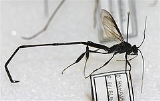
Proctotrupoidea
Encyclopedia
The Hymenoptera
n superfamily Proctotrupoidea is a somewhat confusing assemblage of taxa, with new families being added (or removed) with surprising frequency, and very little to unify them all into a single natural group. It seems quite likely that the superfamily, as presently understood, is polyphyletic, consisting of at least two groups of otherwise unrelated wasps that have been lumped together because of superficial similarities and historical artifacts of classification. At least the following "clusters" of families do appear to be good groups: Austroniidae, Diapriidae
, Maamingidae and Monomachidae in one group, and Heloridae, Pelecinidae, Peradeniidae, Proctotrupidae, and Vanhorniidae in another. The affinities of Proctorenyxidae and Roproniidae (which are closely related to one another) are still uncertain.
Only two of these families (Diapriidae and Proctotrupidae) have a substantial number of species - together they contain over 2000 species. The others are all tiny, often relictual groups. See links for individual families for details of life history and diversity.
Hymenoptera
Hymenoptera is one of the largest orders of insects, comprising the sawflies, wasps, bees and ants. There are over 130,000 recognized species, with many more remaining to be described. The name refers to the heavy wings of the insects, and is derived from the Ancient Greek ὑμήν : membrane and...
n superfamily Proctotrupoidea is a somewhat confusing assemblage of taxa, with new families being added (or removed) with surprising frequency, and very little to unify them all into a single natural group. It seems quite likely that the superfamily, as presently understood, is polyphyletic, consisting of at least two groups of otherwise unrelated wasps that have been lumped together because of superficial similarities and historical artifacts of classification. At least the following "clusters" of families do appear to be good groups: Austroniidae, Diapriidae
Diapriidae
Diapriidae is a family of insects belonging to the order Hymenoptera. These tiny wasps are typically parasitoids on the larvae and pupae of a wide range of insects, especially flies; a few are hyperparasitoids...
, Maamingidae and Monomachidae in one group, and Heloridae, Pelecinidae, Peradeniidae, Proctotrupidae, and Vanhorniidae in another. The affinities of Proctorenyxidae and Roproniidae (which are closely related to one another) are still uncertain.
Only two of these families (Diapriidae and Proctotrupidae) have a substantial number of species - together they contain over 2000 species. The others are all tiny, often relictual groups. See links for individual families for details of life history and diversity.

